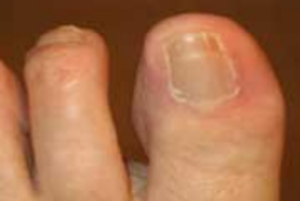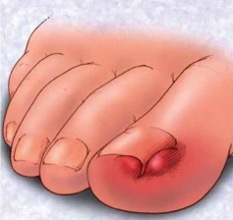A partial nail avulsion (PNA) provides a professional, safe and effective solution to the problem of frustrating and painful ingrown toenails. This is one of the most common procedures carried out in our clinic. An ingrown toenail is a painful condition of the toe. It occurs when a sharp corner of the toenail digs into the skin at the end of or side of the toe. Pain and inflammation at the spot where the nail curls into the skin occur first. Later, the inflamed area can begin to grow extra tissue or drain yellowish fluid. If left untreated, an ingrown toenail can progress to an infection or even an abscess that requires surgical treatment. Any toenail can become ingrown, but the condition is usually found in the big toe.
There are many causes for ingrown nails, but the two most common causes are poorly fitting shoes and improperly trimmed nails. Tight shoes compress the side of the nail and alter the fit of the nail in the groove. When nails are peeled off or torn, the edge of the nail can extend down into the corner of the nail groove. A torn nail can irritate the skin next to the nail, producing inflammation (swelling, pain, and redness) and sometimes infection.
The procedure removes the small part of the toenail edge that is growing downwards/inwards, piercing the skin and causing your painful symptoms. We see fantastic results from this procedure and have great satisfaction with it, especially as many patients struggle with recurring ingrown toenails for years before having the procedure.
When Is Ingrown Toenail Removal Necessary?
Ingrown toenails irritate the skin. As a result, they can make it easier for bacteria and other microbes to get in, which increases the risk of infection. Promptly treating an ingrown toenail reduces this risk. Some signs of infection include:
- swelling
- pus
- redness
- extreme pain
- a fever
Ingrown Toenail Removal Procedure:
Ingrown toenail surgery usually involves the use of local anesthesia. Local anesthesia means that the person remains awake, but the doctor numbs the area so that the person cannot feel their toe. A chiropodist removes a portion of the toenail to prevent it from digging into the skin. This procedure is also called a partial nail avulsion.
- We first inject the toe with a common local anaesthetic using the thinnest needle possible for your comfort
- When the area is numb, we will perform the procedure in which a very small piece of nail along the edge that is growing into the skin is cut away and is pulled out
- If you already have an infection, it will be surgically drained and any overgrown tissue is cut away
- Where a chemical matrixectomy is part of the procedure, we apply the chemical (phenol) to the exposed nail base, before flushing it away and neutralising the area
- We dress the toe with a number of dressing materials for optimal healing
It is important to note that while the procedure, when completed with a chemical matrixectomy, does destroy the nail growing cells, there is always a chance that over time, these cells will heal and regenerate. Unfortunately, this is completely out of our control, as it depends completely on your body’s reparative response. We estimate permanent success in 4 out of 5 patients that we treat at Perform Podiatry. The way we distinguish cell regeneration vs. an ineffective procedure is the time between when symptoms develop. If your procedure was unable to completely remove the ingrown toenail, you should notice pain in the toe within the first few months after the procedure, indicating that the original nail was not completely removed. If this is the case, you must notify us immediately and come in for us to fix the problem. If your symptoms arise 12+ months after the procedure, this is a clear indication that the either your body has regenerated the nail-growing cells, or that re-injury has occurred through other methods in your control, such as continuing to wear tight, restrictive footwear that pushes the skin on your toe into the nail.
The benefits of a PNA include:
- The procedure is done simply in-clinic
- The total appointment time typically doesn’t exceed 60 minutes (with the procedure time typically around 20 minutes)
- The procedure is performed under local anaesthetic so is pain-free
- You do not need to take any additional time off work/school following the procedure and can go home immediately
- You do not need any special boots or braces while the toe heals
- The procedure causes very little post-procedure discomfort, however, painkillers can be taken should discomfort arise
- We dress your toe. A take-home dressing pack can be purchased at our clinic. We will provide the re-dressing instructions.
- We monitor your progress to ensure it is healing well
Recovery
Recovery time is anywhere from two weeks to two months barring any complications such as infection. We provide the post-op shoe and aftercare instructions, all tailored individually to your needs. You should keep your foot elevated for a few hours and rest on the day of the surgery; the next day, you can return to work or school. You should refrain from running or vigorous exercise for at least 2 weeks after the surgery. Avoid strenuous/ high impact exercise or sport until the nail bed has fully healed. For most people, the wound will heal within several weeks. The pain will steadily lessen in the days following surgery and should have gone by the time the wound heals.
A person can help speed their recovery after ingrown toenail surgery by:
- soaking the foot in warm water or Epsom salts every day
- taking ibuprofen (brand names: Advil, Motrin, Nuprin), to help with pain and swelling
- keeping the wound clean and dry, except when showering or cleaning the area
- keeping the wound bandaged until it heals, which usually takes several weeks
- avoiding strenuous activity that puts pressure on the nail
- wearing properly fitted shoes that are not too tight
- avoiding picking at the wound
Ingrown toenail- before surgery
Ingrown toenail after partial nail avulsion.





